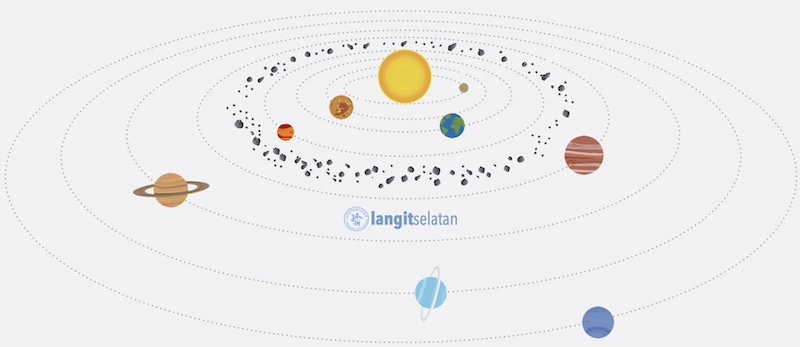Earth is our home. In the past, Earth was thought to be the center of the Universe, where the Sun and the planets revolved around the Earth. However, scientific developments show that the Earth is not the center of the Universe. Earth is one of the planets in the Solar System.
” data-medium-file=”https://i0.wp.com/langitselatan.com/wp-content/uploads/2020/04/bidang-orbit-tasur.jpg?fit=300%2C130&ssl=1″ data-large-file=”https://i0.wp.com/langitselatan.com/wp-content/uploads/2020/04/bidang-orbit-tasur.jpg?fit=800%2C347&ssl=1″ width=”800″ height=”347″ alt=”” class=”wp-image-30966″ srcset=”https://i0.wp.com/langitselatan.com/wp-content/uploads/2020/04/bidang-orbit-tasur.jpg?w=800&ssl=1 800w, https://i0.wp.com/langitselatan.com/wp-content/uploads/2020/04/bidang-orbit-tasur.jpg?resize=300%2C130&ssl=1 300w, https://i0.wp.com/langitselatan.com/wp-content/uploads/2020/04/bidang-orbit-tasur.jpg?resize=768%2C333&ssl=1 768w, https://i0.wp.com/langitselatan.com/wp-content/uploads/2020/04/bidang-orbit-tasur.jpg?resize=304%2C132&ssl=1 304w, https://i0.wp.com/langitselatan.com/wp-content/uploads/2020/04/bidang-orbit-tasur.jpg?resize=296%2C128&ssl=1 296w” sizes=”(max-width: 800px) 100vw, 800px” data-recalc-dims=”1″/>
–
NahThe Solar System itself is a system or arrangement of planets around a star called the Sun. And as in the previous article about the life of stars, this Sun was born from a giant molecular cloud that collapsed. We know it as the solar nebula.
Again another question arises. How Earth and other planets formed?
Of course Earth and other planets would not exist if the Sun did not exist. And this story begins with the birth of the Sun, 4.6 billion years ago.
The sun formed from a giant gas cloud that collapsed. These clouds are dominated by hydrogen and helium, but there are other elements such as carbon, nitrogen, and silicates. When there is a disturbance in the form of a shock wave from the explosion of another nearby star, the cloud becomes unstable. As a result, the clouds collapsed and began to attract material that fell to the center to form the forerunner of the Sun. During this process, there is an increase in the temperature at the center which in turn generates the combustion reaction of hydrogen into helium.
Voila… The sun was born.
As it turns out, not all of the matter or gas in the clouds formed the Sun. There is still dust and gas that forms a ring or disk around the Sun. This ring that contains gas and dust we call the protoplanetary disk because it is in this ring that the planets are formed.
At the center of the star aka the Sun, the temperature is very high, which means the temperature is very hot. However, the further away from the star, the colder the temperature. As a result, gas near the star will evaporate while those far away can remain in the form of gas or even become ice if it is very far from the star.
It should also be borne in mind that the gas and dust in this disk rotates or spins. These gas and dust particles collide with each other and combine to form micro-sized grains. This merger became the forerunner of the formation of planets in the protoplanetary disk.
To be sure, the time of the formation of the planet is a time full of violence. How come! The particles of matter in the disk move and collide with other grains. As a result, larger and denser particles are formed.
The crashes never stop. These clumps continued to collide with the material on the disk and coalesced to form planetesimals. Well, these planetesimals are still colliding and merging with other clumps of matter until they eventually form protoplanets or the forerunner of planets. The same process continues and the protoplanets attract other planetesimals of similar composition to combine and form planets.
Because the temperature near the Sun is very hot, the planetesimals near the Sun are in the form of rocks and metals. So that rocky planets such as Mercury, Venus, Earth, and Mars are formed.
The further away from the Sun, the lower the temperature and the colder it gets, so that material that freezes into ice begins to be found. When this ice flake combines with rock and metal planetesimals, it forms a very large planetary core. This giant planet’s core then captures more hydrogen and helium gas which forms a super thick atmosphere. The result is a gas giant planet with a solid rock core.
On the cold outer side of the disk, frozen planetesimals remain, which then coalesce to form small bodies several kilometers across. These objects then inhabit an area known as the Kuiper Belt.
Meanwhile, there are other small objects or let’s call it rock fragments measuring a few meters to 1000 km between Mars and Jupiter. Planetesimals in this area are remnants of the formation of the Solar System that failed to merge to form planets due to gravitational disturbances from Jupiter.
In addition to planets, there are also satellites or moons or planetary companions. Satellites on giant planets are thought to have formed through the same process as planets. For satellites on rocky planets such as the Moon on Earth or the two Mars satellites, the satellites are formed from the planet’s collision with other objects that are quite large or are simply the result of the planet’s gravity.
This article is a collaboration between detikEdu and Langitselatan and has been published on the portal detikEdu.
Related
–


